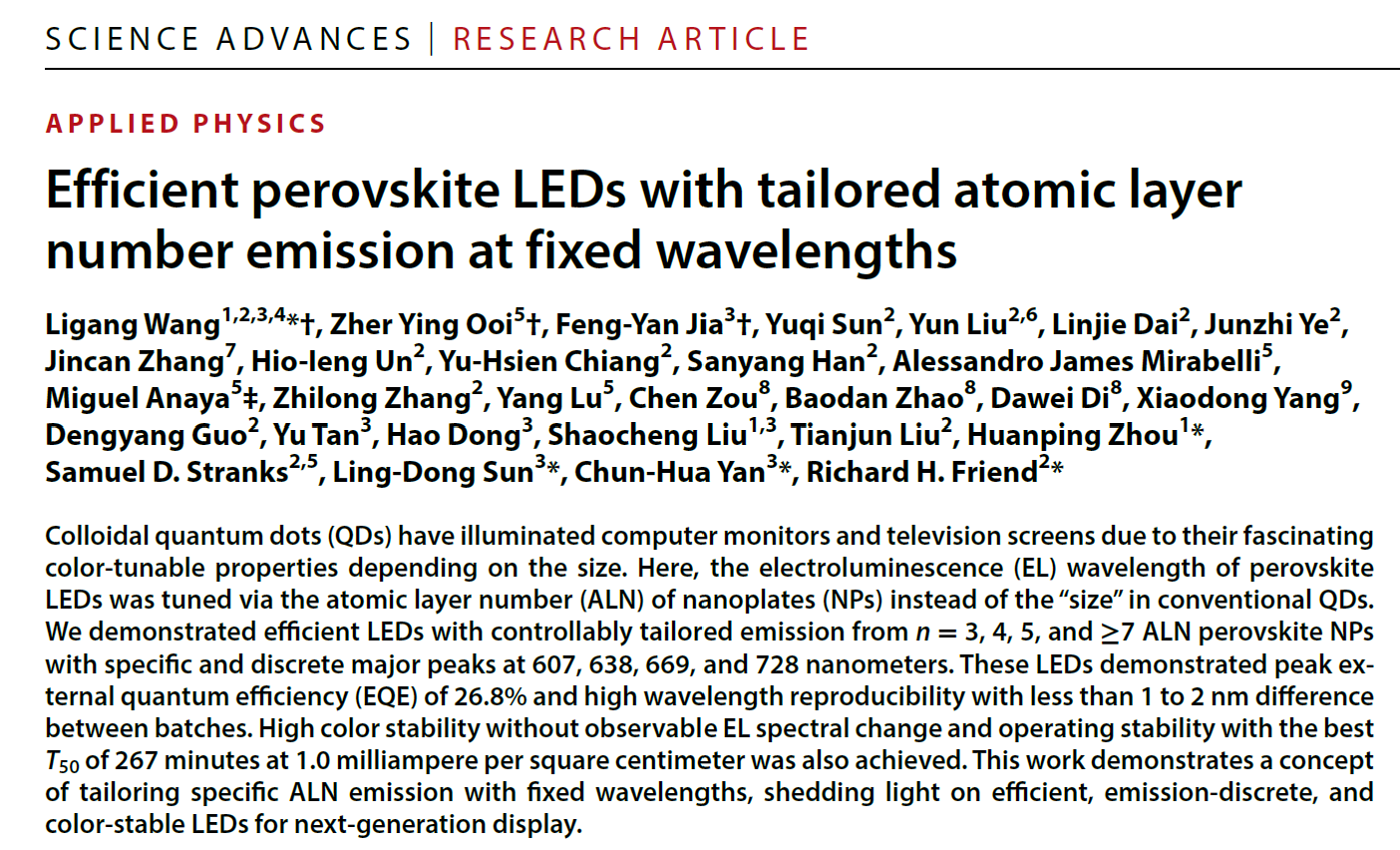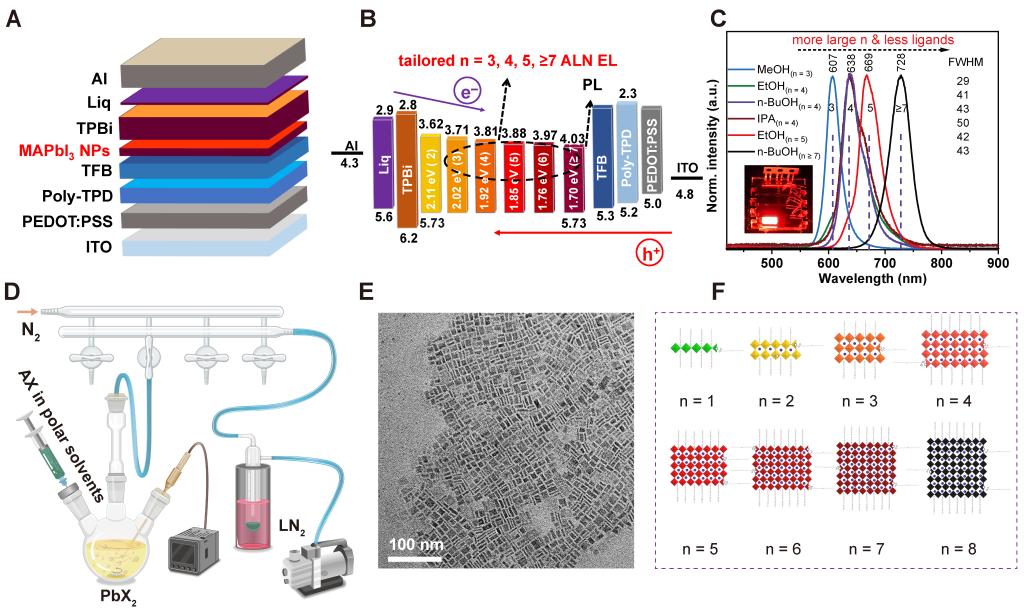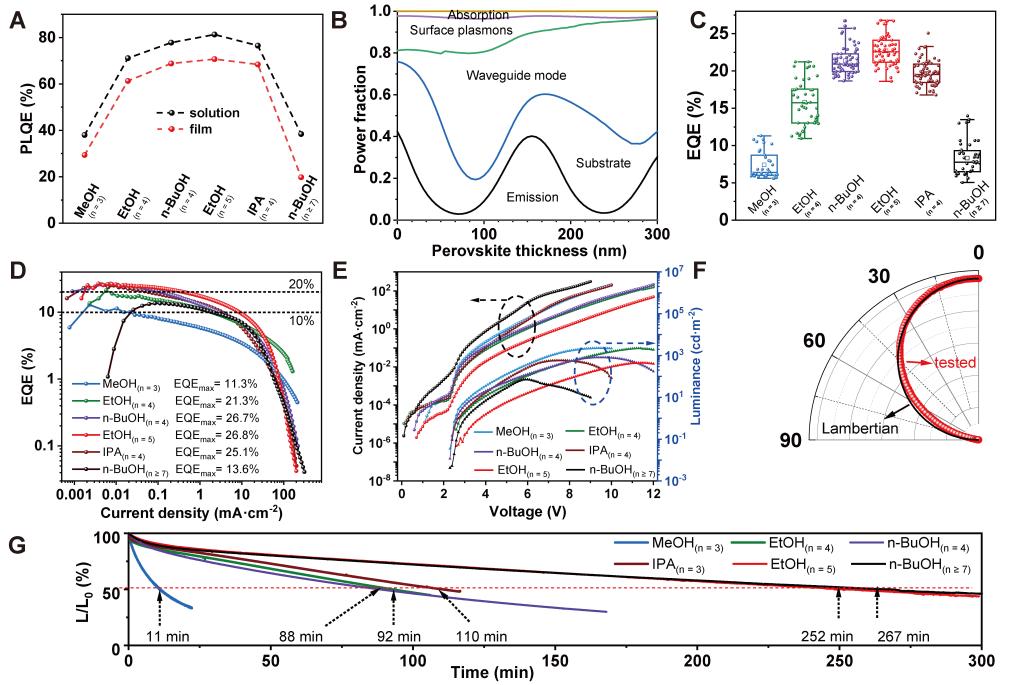Since their discovery in the 1980s, quantum dots have been widely applied in various fields, including display technologies. The research team led by Professor Ligang Wang from the School of Advanced Materials (SAM), Peking University Shenzhen Graduate School, in collaboration with Professor Huanping Zhou from the School of Materials Science and Engineering, Professors Chunhua Yan and Lingdong Sun from the College of Chemistry and Molecular Engineering, and Professor Richard Friend from the Cavendish Laboratory, University of Cambridge, has successfully developed high-efficiency light-emitting diodes (LEDs) based on quantum dots with tunable numbers of atomic layers. The electroluminescence peak of these LEDs can be precisely tuned from 607 to 728 nm, achieving an impressive external quantum efficiency (EQE) of 26.8%. This breakthrough holds great significance for high-definition display applications and was published on February 14, 2025, in the internationally renowned journal Science Advances, under the title “Efficient perovskite LEDs with tailored atomic layer number emission at fixed wavelengths” (DOI: 10.1126/sciadv.adp9595).

Figure 1. Screenshot of the Published Paper Interface
In 2023, the Nobel Prize in Chemistry was awarded to three scientists who pioneered the invention of colloidal quantum dots. With their wide color gamut, narrow emission peaks, and high EQE, quantum dots meet the core requirements for next-generation high-definition display technologies. Traditionally, the emission color of quantum dots has been tuned by controlling their size; however, the particle size is highly sensitive to various synthesis conditions, such as precursor composition, reaction temperature and duration, and ligand type and ratio. This often results in poor reproducibility of emission wavelengths.
Lead halide perovskite quantum dot LEDs have attracted tremendous attention from both academia and industry due to their ultrahigh efficiency, solution-processability, and broad spectral coverage from blue to infrared. Nevertheless, previous studies on perovskite LEDs typically relied on bandgap tuning via mixed-halide compositions, which are prone to halide segregation under photoexcitation or electrical bias, leading to unstable emission colors.
Furthermore, the energy funneling effect poses another critical challenge: in quasi-2D perovskite systems with multiple n values (i.e., multiple bandgaps), emission predominantly originates from phases with smaller bandgaps and longer wavelengths (larger n values). Both Förster resonance energy transfer (FRET) and charge transfer mechanisms have been proposed to explain this phenomenon. However, the exact mechanism of energy funneling—and its distinction between photoluminescence and electroluminescence—remains not fully understood.

Figure 2. MAPbI3 Perovskite Quantum Dot LEDs with Different Atomic Layer Numbers
To address the aforementioned challenges, Ligang Wang and collaborators proposed, for the first time, a new strategy to control the electroluminescence wavelength of LEDs by tuning the number of atomic layers in quantum dots. This breakthrough was made possible through a newly developed nanomaterial synthesis technique — the Fast-Evaporating Polar Solvent–Assisted (FEPS) method for perovskite quantum dot synthesis. In this approach, a polar-solvent solution (e.g., water or alcohol) of the A-site cation precursor is injected into a lead halide solution, followed by rapid removal of the polar solvent via vacuum flash evaporation, yielding high-quality perovskite quantum dots. By selecting different polar solvents and post-treatment conditions, the researchers successfully obtained perovskite quantum dots with varied atomic layer numbers, enabling precise control over their emission wavelengths.
Based on this synthesis route, the team achieved precise electroluminescence wavelength tuning corresponding to 3-, 4-, 5-, and 7-layer perovskite quantum dots, resulting in emission peaks at 607, 638, 669, and 728 nm, respectively — perfectly matching the red light wavelength standards required for different display technologies. Importantly, since the emission wavelength depends on the integer number of atomic layers rather than on particle size or halide composition (which are sensitive to preparation conditions), these LEDs demonstrated exceptional reproducibility, with wavelength deviations of less than 1 nm across batches — a remarkable improvement over conventional quasi-2D perovskite LEDs, which often exhibit deviations up to 40 nm. Moreover, the LEDs exhibited high color purity (full width at half maximum, FWHM = 29–43 nm), significantly narrower than that of conventional quasi-2D perovskite materials (FWHM = 61 nm). The devices also achieved an EQE of 26.8%, along with outstanding operational and color stability, highlighting their great potential for next-generation ultra-high-definition display technologies.
Carrier dynamics studies further revealed that charge transfer is the dominant energy transfer pathway under LED operation conditions. In these quantum dot LEDs, the relatively slow charge transfer rate and the low probability of Förster resonance energy transfer (FRET) lead to a noticeable blue shift in electroluminescence compared with photoluminescence — indicating that more photons are emitted from small-n quantum dots. This discovery clarifies the long-standing debate on the mechanisms of energy funneling (FRET vs. charge transfer) in multi-n perovskite systems, providing important theoretical guidance for the rational design of high-performance quantum dot LEDs.

Figure 3. Performance of Quantum Dot LEDs with Different Atomic Layer Numbers
The paper’s first authors are Ligang Wang, Research Fellow and Assistant Professor at the SAM, Peking University Shenzhen Graduate School; Zher Ying Ooi, Ph.D. candidate at the University of Cambridge; and Fengyan Jia, a Ph.D. graduate from the research group of Professor Chunhua Yan at the College of Chemistry and Molecular Engineering, Peking University. The corresponding authors are Ligang Wang, Professor Huanping Zhou, Professor Lingdong Sun, Academician Chunhua Yan, and Professor Sir Richard Friend from the University of Cambridge. Other collaborators include researchers from the University of Cambridge, Zhejiang University, and other institutions. This research was jointly supported by the Royal Society Newton International Fellowship (UK), the National Natural Science Foundation of China (NSFC), the Ministry of Science and Technology of China, the Beijing Natural Science Foundation, and the European Research Council (ERC).
